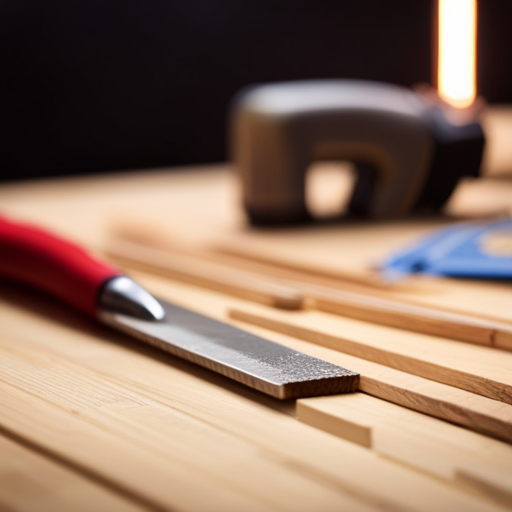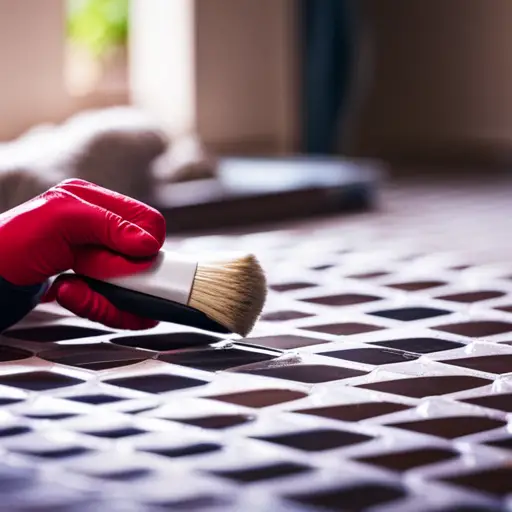The Role of Underlayment in Flooring Installation

The role of underlayment in flooring installation is akin to the foundation of a sturdy building—essential for stability and longevity. This article delves into the significance of underlayment, exploring its impact on flooring stability, sound reduction benefits, and moisture protection.
By examining various types of underlayment and their compatibility with different flooring materials, this piece aims to provide a comprehensive understanding of the underlayment’s vital role in ensuring long-term performance.
Importance of Underlayment
The importance of underlayment in flooring installation cannot be overstated, as it provides crucial support and protection for the flooring material. Underlayment offers numerous benefits, including sound absorption, moisture protection, and thermal insulation. It also helps to smooth out minor imperfections in the subfloor, creating a more even surface for the flooring material. Proper installation techniques are essential to ensure that the underlayment performs effectively. This includes careful preparation of the subfloor, accurate measurements, and secure fastening of the underlayment material.
When considering underlayment materials, various options exist, such as cork, rubber, foam, and plywood. Each material has its own unique properties and benefits, so it’s important to select one that aligns with the specific needs of the flooring and the environment in which it will be installed. Cost considerations are also significant, as different materials vary in price and may impact the overall budget of the flooring project. Therefore, it is essential to weigh the benefits of each material against its cost to make an informed decision.
Transitioning into the subsequent section about ‘types of underlayment’, understanding the different materials available is crucial for selecting the most suitable underlayment for a specific flooring installation.
Types of Underlayment
An array of underlayment materials is available, each offering distinct properties and advantages, allowing for tailored selection based on the specific requirements of the flooring and its installation environment.
Common underlayment materials include:
- Foam underlayment, often made from polyethylene or polystyrene, is lightweight and easy to install, making it suitable for floating floor installation.
- Cork underlayment provides natural insulation and sound absorption, making it an excellent choice for reducing noise transmission.
- Rubber underlayment offers exceptional durability and moisture resistance, making it suitable for areas prone to moisture.
- Felt underlayment, typically made from recycled fibers, provides cushioning and is often used with hardwood and laminate flooring.
- Acoustical underlayment, designed specifically for sound reduction, is ideal for spaces where noise control is crucial.
Each underlayment material requires specific installation methods to ensure optimal performance. Therefore, understanding the characteristics and installation requirements of each underlayment material is essential for achieving a successful flooring installation.
Impact on Flooring Stability
The stability of flooring is crucial for ensuring durability and safety in a space. Proper underlayment plays a pivotal role in maintaining the stability of flooring, providing support and cushioning to the surface.
When considering the impact on flooring stability, it’s essential to take into account the type and quality of underlayment material. The underlayment material should be chosen based on the specific needs of the flooring, such as moisture resistance or sound absorption. The quality of the underlayment material will determine its ability to withstand pressure and distribute weight evenly, thus contributing to the stability of the flooring.
In addition to the type and quality of underlayment material, proper installation methods are crucial for maintaining flooring stability. This includes ensuring that the underlayment is installed correctly, with no gaps or unevenness. The underlayment should also be securely attached to the subfloor to prevent movement or shifting.
Underlayment and Floor Stability
Floor stability significantly impacts the overall performance and longevity of flooring installations. Proper subfloor preparation, including floor leveling, is crucial for ensuring the stability of the flooring. Uneven subfloors can lead to premature wear and damage to the flooring material, affecting its aesthetic appeal and structural integrity.
Utilizing underlayment materials can help address minor subfloor irregularities and provide a stable base for the flooring. Additionally, underlayment can act as a moisture barrier, preventing any potential moisture-related issues that could compromise the stability of the flooring over time.
Importance of Proper Underlayment
Proper underlayment significantly impacts flooring stability, ensuring a durable and long-lasting installation. The selection of appropriate underlayment and the use of correct installation techniques are crucial for maintaining the stability of the flooring. Below is a table illustrating the impact of underlayment on flooring stability:
| Underlayment Selection | Installation Techniques | Impact on Flooring Stability |
|---|---|---|
| Quality materials with appropriate thickness | Proper moisture barrier installation | Provides support and minimizes wear |
| Compatibility with flooring type | Correct seam sealing | Reduces movement and noise |
| Adequate insulation properties | Accurate leveling and smoothing | Enhances thermal and sound insulation |
The proper selection and installation of underlayment materials directly influence the overall stability of the flooring, contributing to its longevity and performance.
Transitioning into the subsequent section about ‘underlayment material considerations’, it is essential to delve into the specific types of underlayment materials and their respective benefits.
Underlayment Material Considerations
Transitioning from discussing the importance of proper underlayment, it is imperative to delve into the specific types of underlayment materials and their respective benefits in ensuring flooring stability.
Underlayment material selection plays a critical role in maintaining the stability and longevity of flooring. Materials like plywood, particleboard, and cement board are commonly used due to their durability and ability to provide a solid foundation for various types of flooring.
Additionally, underlayment thickness considerations are crucial in ensuring proper support for the flooring material. Thicker underlayment can help in leveling out minor subfloor imperfections and enhancing the overall stability of the flooring.
Understanding the characteristics and advantages of different underlayment materials, as well as considering the appropriate thickness, is fundamental in achieving a stable and long-lasting flooring installation.
Sound Reduction Benefits
When properly installed, underlayment significantly reduces sound transmission in flooring installations. This soundproofing benefit is particularly important in multi-level buildings, where impact noise from footsteps and other sources can disrupt occupants in lower levels.
The use of underlayment has a direct impact on acoustics by absorbing and dampening sound waves, resulting in a quieter and more comfortable indoor environment. The underlayment material plays a crucial role in achieving these sound reduction benefits.
For instance, rubber underlayment is known for its exceptional sound-dampening properties, making it an ideal choice for areas where noise reduction is a priority. Additionally, cork underlayment is highly effective in reducing both impact noise and airborne sound transmission, contributing to a peaceful living or working space.
Moisture Protection
Effectively addressing moisture protection is crucial in flooring installations, and underlayment plays a key role in achieving this. When it comes to moisture protection, underlayment serves as a crucial element in safeguarding the flooring and subfloor from potential water damage.
Key aspects to consider regarding moisture protection in flooring installations include:
-
Moisture barrier: Underlayment acts as a moisture barrier, preventing water and vapor from reaching the flooring material, thus protecting it from swelling, warping, or mold growth.
-
Subfloor protection: The underlayment provides an additional layer of defense for the subfloor, shielding it from moisture infiltration and potential damage, thereby prolonging its lifespan.
-
Underlayment selection, installation techniques: Selecting the appropriate underlayment material and utilizing proper installation techniques are essential in ensuring effective moisture protection, as different flooring types may require specific underlayment characteristics and installation methods tailored to mitigate moisture-related issues.
By carefully considering these aspects, underlayment can effectively contribute to moisture protection in flooring installations, ensuring the longevity and durability of the flooring system.
Now, let’s delve into the subsequent section about the ‘underlayment installation process’.
Underlayment Installation Process
How should the underlayment installation process be approached to ensure optimal functionality and durability of the flooring system?
The first step is to carefully select the appropriate underlayment materials based on the specific requirements of the flooring and the subfloor. For example, for laminate or engineered wood flooring, foam or cork underlayment is often used to provide cushioning and sound absorption. On the other hand, for tile or stone flooring, cementitious backer board or uncoupling membranes may be more suitable to support the weight and prevent cracks.
Once the underlayment materials are chosen, proper installation techniques must be followed. This includes ensuring that the subfloor is clean, dry, and level before laying down the underlayment. Proper seams and joints must be secured to prevent any movement or shifting. Additionally, fasteners or adhesives should be applied according to the manufacturer’s recommendations to guarantee a strong bond. Attention to detail during the underlayment installation process is crucial to avoid future issues with the flooring system.
Moving on to the subsequent section about ‘compatibility with flooring materials’, it is essential to ensure that the underlayment chosen is compatible with the specific type of flooring material being installed.
Compatibility With Flooring Materials
The compatibility of underlayment with various flooring materials is a critical consideration in ensuring long-term performance and stability of the flooring system. When selecting underlayment materials, it is important to consider their compatibility with different types of flooring to maximize the benefits they provide. Here are key points to consider:
-
Moisture Barrier: Some underlayment materials, such as rubber or foam, may not be suitable for moisture-prone areas when installing hardwood or laminate flooring. In such cases, using a moisture barrier underlayment can prevent moisture-related issues and prolong the life of the flooring.
-
Sound Absorption: Underlayment materials vary in their ability to absorb sound. For instance, cork underlayment is excellent for sound reduction when installing hardwood, laminate, or engineered wood flooring, making it ideal for apartments or multi-level homes.
-
Subfloor Compatibility: Certain underlayment materials are designed to be compatible with specific subfloor types. For example, some underlayments are engineered for use over concrete subfloors, while others are suitable for wood subfloors.
Understanding the compatibility of underlayment materials with different flooring types is essential for achieving optimal performance and longevity of the flooring system.
This compatibility ensures that the underlayment enhances the flooring’s characteristics and provides the necessary support for long-term durability and stability.
Long-Term Performance
To ensure the long-term performance of a flooring system, it is essential to consider the ongoing compatibility of the underlayment with the chosen flooring materials and the anticipated usage of the space. Underlayment longevity is crucial for maintaining the structural integrity of the flooring over time. Additionally, maintenance considerations play a significant role in ensuring the underlayment continues to provide the necessary support and cushioning for the flooring materials.
| Longevity Factors | Maintenance Considerations |
|---|---|
| Material Quality | Regular Inspections |
| Moisture Resistance | Cleaning and Repairs |
| Compression Resistance | Proper Installation |
The longevity of the underlayment depends on factors such as the quality of materials used, its resistance to moisture, and its ability to withstand compression from foot traffic. Regular inspections should be conducted to identify any signs of wear or damage. Maintenance activities, including cleaning and repairs, are essential for preserving the underlayment’s functionality. Proper installation of the underlayment is also crucial for maximizing its lifespan and ensuring long-term performance. By considering these factors, the underlayment can effectively support the flooring materials and contribute to the longevity of the entire flooring system.
Frequently Asked Questions
What Are the Most Common Mistakes People Make When Installing Underlayment?
Common mistakes in underlayment installation include improper materials and inadequate preparation. Proper installation is crucial for a successful flooring project. Neglecting these factors can lead to uneven surfaces, reduced insulation, and increased risk of damage.
Can Underlayment Be Used in All Types of Flooring Installations, or Are There Certain Materials It Is Not Compatible With?
When considering compatible materials for underlayment, it’s crucial to assess the specific flooring type. Proper installation techniques are essential, as certain materials may not interact favorably with underlayment, impacting the overall flooring installation.
Are There Any Special Considerations or Precautions to Take When Installing Underlayment in High-Moisture Areas, Such as Bathrooms or Kitchens?
When installing underlayment in high-moisture areas like bathrooms or kitchens, it’s crucial to incorporate a moisture barrier and ensure thorough subfloor preparation. Consider installation techniques and material compatibility to maintain long-term flooring integrity.
How Can Underlayment Impact the Warranty and Long-Term Performance of Different Types of Flooring Materials?
The impact of underlayment on flooring durability is significant. Underlayment material comparisons reveal how it can affect warranty and long-term performance. For instance, using a moisture-resistant underlayment can enhance the longevity of hardwood flooring in high-moisture areas.
Are There Any Environmental or Sustainability Factors to Consider When Choosing Underlayment Materials?
When choosing underlayment materials, it’s crucial to consider their environmental impact and sustainability. Opting for sustainable materials can reduce the overall environmental footprint of the flooring installation, aligning with eco-friendly practices and standards.
Conclusion
In conclusion, underlayment plays a crucial role in flooring installation by providing stability, sound reduction, and moisture protection.
A study conducted by the National Wood Flooring Association found that proper underlayment can increase the lifespan of flooring by up to 50%.
These benefits make underlayment an essential component in ensuring the long-term performance and durability of flooring materials.
Understanding the importance of underlayment is key to a successful flooring installation.

Rubin Everest, a seasoned expert in the world of flooring, brings a wealth of knowledge and passion to the surface. As the mind behind ebbow.com, Rubin is dedicated to sharing insights on the latest trends, innovative solutions, and expert advice in the realm of flooring. Whether you’re seeking practical tips for installation or design inspiration, Rubin Everest is your go-to source for all things flooring-related, making your journey to the perfect floor an informed and enjoyable experience.




